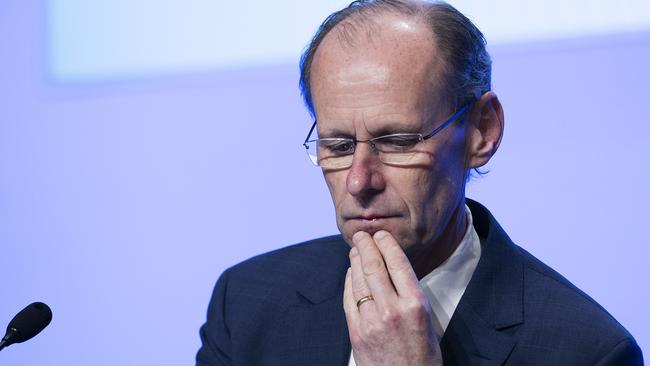
The 2.4 per cent fall in the bank stock price to $18.70 was due more to overall market sentiment than specific ANZ issues and the bank is in good shape ahead of any downturn.
It has increased provisions to $5bn and its 11.4 per cent capital ratio is $4bn above regulatory minimums. ANZ chief executive Shayne Elliott made clear his view on next week’s RBA meeting, which put simply is that liquidity is not the issue and rather it’s COVID-led global uncertainty, which means any conventional or unconventional moves from the RBA would go to waste.
The market is already pricing on a cut in the short-term rate from 25 to 10 basis points, the three-year note target from 25 to 10 basis points, and signalling increased government bond purchases.
The moves are aimed to show the RBA is here to help, but the practical impact in the view of Elliott and others would be zero.
It makes more sense for the RBA to hold its help until at least after the fiscal handouts stop next April.
The cash rate in the market now is eight basis points and the three-year note is at 12 points.
Asked of the impact of recent federal government initiatives, Elliott, who confided he paid $400m last year through the bank levy on top of $1.7bn in other taxes, said the relaxation of responsible lending rules had zero impact but the budget measure to allow instant asset write-offs had resulted in increased activity.
ANZ is not a big player in the small business market but its $12bn book was down 6 per cent in the year, which tells you small business doesn’t want to increase debt right now.
The federal government of course would prefer everyone borrowed more and spent more to get the economy moving but small business is in a “fighting for survival” mode and doesn’t want to increase debt.
Elliott also confided that the ANZ board this week had a look at the “buy now, pay later” market in the wake of Westpac’s white label deal with Afterpay.
But on his summation, ANZ is not about to rush into the market.
Deposit growth is already strong, up 12 per cent or $34bn last year to $329bn, as 90 per cent of the economy is still employed to pour more money into savings rather than spending.
BNPL customers are younger and riskier and tend to have low balances in any case, which is why they are deferring payment terms now.
The sector, while still small, is growing fast and is just another of the myriad of potential competitors the banking industry faces, fuelled by technological changes that have lowered barriers to entry and backed by government initiatives such as consumer data rights, which makes it easier to swap to other players.
No need for bank branches in this world and ANZ in fact noted that its broker-originated mortgages increased to nearly two-thirds of new loans, up from just over half the book normally.
This was due to the COVID-19 closure of branches.
Elliott also noted his albeit shrinking margins are somebody else’s opportunity.
He has recently hired former Woolworths executive Emma Gray to run his data program backed by new technology as part of a $1.8bn investment spend.
Combined with the COVID fact that everyone is paying by card, ANZ knows on the day which coffee shop you went to before buying a new pair of shoes and settling into a long lunch of Wagyu beef and upmarket shiraz.
This means when you apply for a housing loan, Elliott will know how good your credit is and when the restaurant is looking for a loan he will know it does much better business than the shop next door.
It’s not only Google that is tracking your movements.
The short-term view says the downturn has not been as bad as feared and the early signs of the bounce back are good, but we won’t really know until next year.
Elliott reported a cash profit 42 per cent or $3.8bn below year ago levels and, while many metrics look weak, with a return on equity at 6.2 per cent against 10.9 per cent a year ago, the bank is actually in good shape to weather any storm.
Its tier-one capital is 11.3 per cent, or $4bn more than the regulatory minimum, and it has increased provisions to $5bn to cover increased loan losses.
The best way to illustrate the uncertainty facing the economy is the local cafe, which may be booming today as folk in Melbourne emerge from a long lockdown, but for example it has six staff today on $1200 a fortnight who a year ago were only earning $500. From January, those people will be earning $1000 and from April 1 they will be back to $250 a week if they still have a job.
The level of handouts is known along with some landlord rent support and bank loan deferrals, but how business reacts next April is unknown.
As Elliott puts it, time has never been cheaper with interest rates at record lows, but the real world starts to catch up next year.
All the banks are shielded in what is a false economy with 50 per cent of workers either already employed by the government or on some sort of wage or benefit support.
Like the other three banks reporting this season, ANZ pre-announced impairments totalling some $2.7bn in an attempt to get the bad news out of the way.
The bad news was the almost non-existent revenue growth.
The bank noted some 95,000 customers deferred their loans and some 43,450 of these were back on full payments.
In all, 55,000 borrowers, or 58 per cent, had made recovery plans with the bank.
The ANZ house view is that the downturn was not as sharp as expected, but the recovery would be longer.
Elliott said that, of the 236,000 small business customers, 23,000 deferred loans and of these 15,000 had made clear recovery plans.
Elliott noted Perth spending on cafes and restaurants was now running at 18 per cent above year-ago levels, but WA is enjoying a resurgence in mining and is coming off several weak years.
The lowering of restrictions in Melbourne were welcomed, but it is too early to call victory even if some restaurants are now booked until Christmas. The final dividend of 35c a share was at a payout ratio of 35 per cent. Return on equity fell from 10.9 per cent to 6.2 per cent, with no revenue growth to speak of.








ANZ’s profits were in line with estimates but the reality is they came in essentially a false economy flush with government liquidity, which means we won’t know the full COVID-19 impact until next year, and the RBA would be wasting its time pumping in more next week.